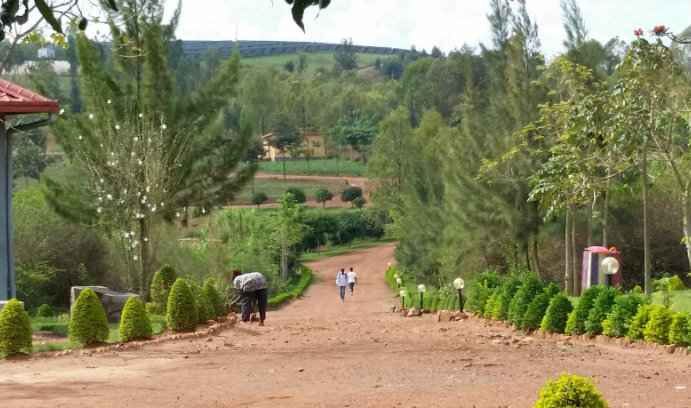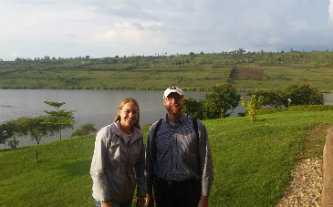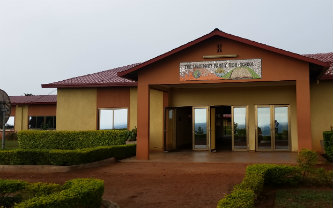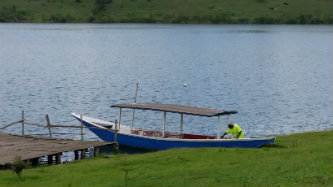Helping orphaned youths in Rwanda

The Agahozo-Shalom Youth Village in Rwanda is home to youths left orphaned and vulnerable by the country’s 1994 genocide. Contributed photo.
The Agahozo-Shalom Youth Village in Rwanda is home to youths left orphaned and vulnerable during or after the country’s 1994 genocidal mass slaughter of 800,000 men, women and children. There, in the rural village in central/eastern Africa, staff work to make sure “tears are dried” (as indicated by the Kinyarwanda word agahozo) and that the youths can “live in peace” (as in the Hebrew word shalom).
As village leaders work to restore hope to the approximately 500 Rwandan youths living on campus, a team of doctoral students in the College of Education is helping to revise their system for monitoring and evaluating the effectiveness of their myriad programs. The Lehigh team is led by Alexander W. Wiseman, associate professor of Comparative and International Education.
In October, Wiseman and one of the graduate students on the Lehigh team, Petrina Davidson, travelled to Rwanda to evaluate first-hand the village’s infrastructure (what are the resources and structures that support monitoring and evaluation in the village?), capacity (what knowledge and skills do village leaders have about monitoring and evaluation?), and sustainability (where are champions to create a sustainable monitoring and evaluation system?).
“They really haven’t had any information to show them what was working and what wasn’t working,” said Wiseman about the program, established in 2008. “So they were going with what they thought was the best idea and approaching it with integrity and the best motives. They ended up with a large number of programs, many not having the results that they anticipated.”
The non-profit organization’s leaders are looking for improved ways to make evidence-based decisions such as how to strengthen weak programs that are really important, he said. “They’d really like to be able to make decisions that are the best for the kids and for the village as a whole, that are based on what they know is working rather than what they feel might be working.”
A visit to Rwanda
In their recent visit to Rwanda, Wiseman and Davidson met with those who work in the village—teachers, principals, “mamas” who live in the homes and “big brothers” and “big sisters” who are on staff and work with the youths. The two spent a lot of time looking at the village’s documentations, assessing what’s in place that already works and what can be built upon or expanded.
“What we’re trying to do is help them establish a village-wide monitoring and evaluation system so that every unit has a way to evaluate what it is doing toward its own goals, and then how all of it is coordinated across the village,” Wiseman said. “Our goal is to help facilitate that.”
Rounding out the Lehigh team are doctoral students Christine Gravelle Lowe and Calley Stevens Taylor.
Lehigh’s involvement with the Agahozo-Shalom Youth Village began a year ago, when Wiseman got a call for assistance from Lehigh alumna Barrett Frankel ’02 ’03 ’11G , who had earned her master’s in Comparative and International Education at Lehigh, specializing in globalization and educational change. Frankel worked in the village in Rwanda and recently served as director of communications at the non-profit organization’s headquarters in New York.
The group’s board and executive director wanted to make sure they were meeting their goals, using their resources wisely and achieving their mission—namely to help the youth in their care.
Wiseman said there are some people in the village, including those who work with teachers, who are already involved in the process of monitoring and evaluation but who are not necessarily carrying it out in a way that’s transferable. The Lehigh team is trying to determine whether the way those individuals collect information—and make decisions based on that information—can be a process that’s shared.
“We’re trying to find people who are already doing a great job, then facilitate a conversation between them and the rest of the village,” Wiseman said. “We need to help them have that awareness and value for something as important, yet often as misunderstood, as monitoring and evaluation.”
Collecting information
Inside the 32 family houses, some “mamas” keep logs of how and what the youths are doing, such as “so and so won the spelling bee today,” said Davidson. And they might make a note of when someone had a health checkup or whether someone had difficulty interacting with someone else in the house.
“It’s great that they’re keeping information like this,” said Wiseman, “but they’re not yet doing it in a way that is consistent. So they can’t really compare how the kids across the village are doing, or share the information in a way that is as helpful as it could be to other people in the village.”
Others work in the transition unit, helping the youths prepare for a vocation or higher education, and others work with the youths in extracurricular activities.
“If one of the kids has an issue or even a joy to be shared, there’s not yet a systematic way to do that across the village,” he said. “There’s not a system for that, or at least there’s not a system that’s working 100 percent.”
Wiseman said it would be easy to say, ‘Here’s how you do it,’ then train staff. “But the problem is, when you do that, as soon as you’re gone, everything begins to fall off because it’s all externally driven and externally motivated,” he said. “So the challenge for us is to support the people who are already leading the charge on the ground in Rwanda and to give them whatever tools or training they need to empower the rest of the village.”
“It’s easy to provide a template,” he continued. “It’s much harder to actually create a sense of ownership or empowerment or value. And quite frankly, that’s what we’re trying to do…so that when we go away, because we will eventually, they don’t start at ground zero again. They’ve got a system, they’ve got an understanding of what to do with it, they value it and want to make it work. If that happens, then it’s a success.”
Posted on:




